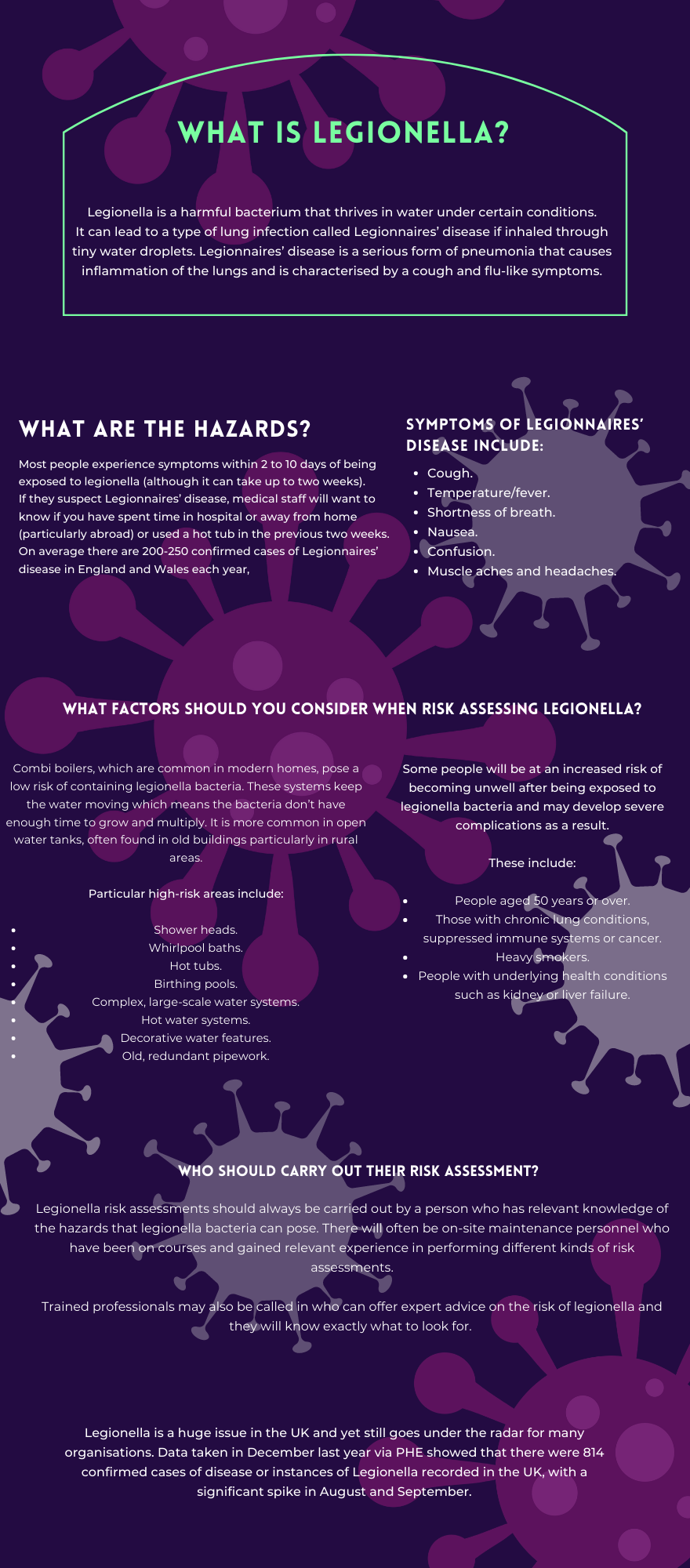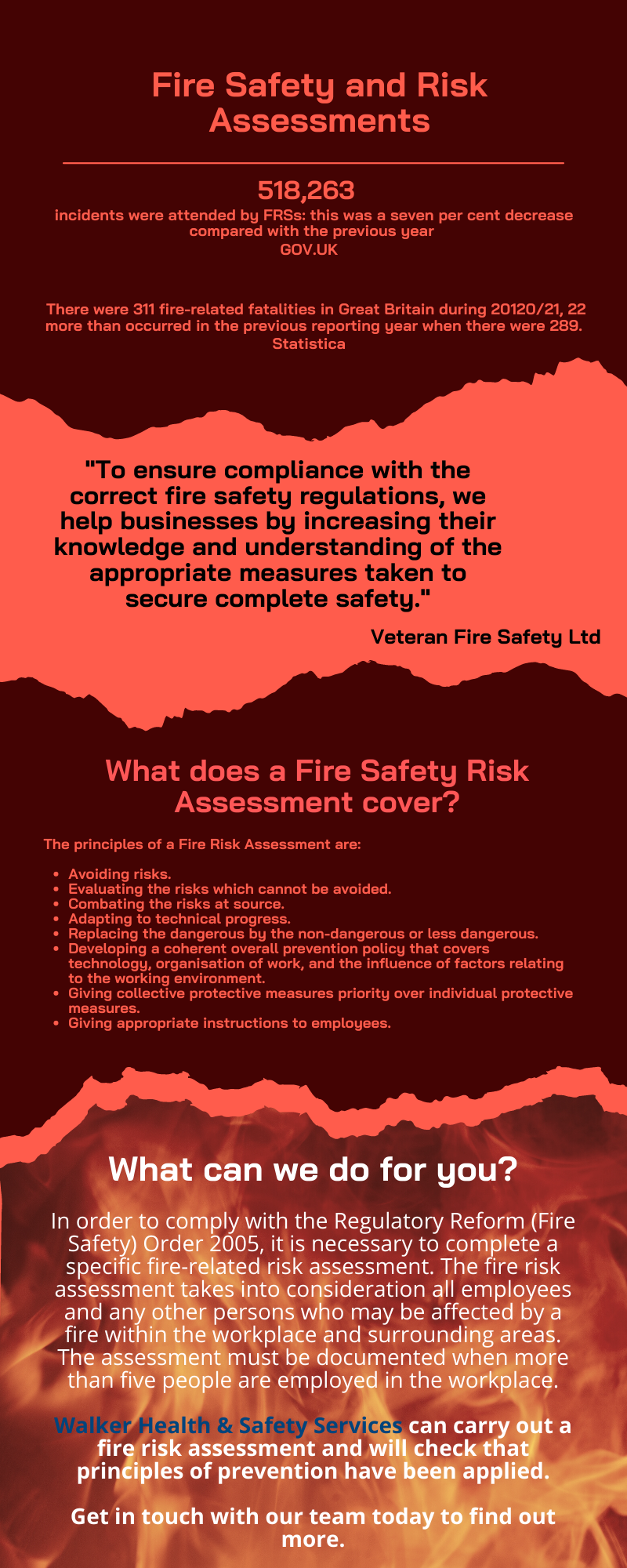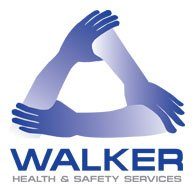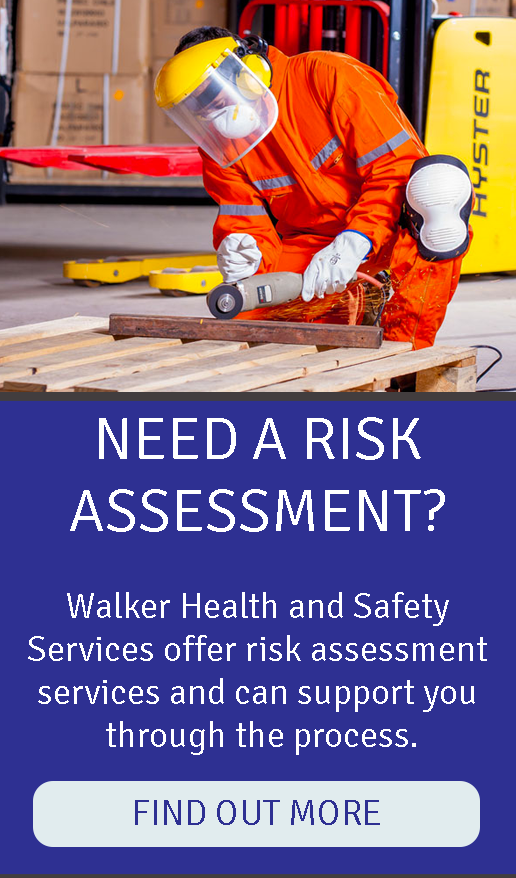A legionella assessment is an essential risk management process. It comprises a detailed examination of the risks presented by man-made water systems, and seeks to identify and assess the risks associated with Legionnaires’ disease through exposure to the bacteria.
We have put together an infographic. I would recommend that you share the information with employees as it could be beneficial to them.
Contact us for further information.

Why have this talk? Exposure to vibration can result in serious injury and disability.
Also, vibration and sound waves can travel through the ground and cause disturbances to the environment and local community, as well as causing structure damage over time.
What will this talk cover? The sources, effects, and methods of overcoming excessive vibration and reducing nuisance to others from vibration.
Who is most at risk? Those who regularly use high-vibration tools, equipment and machines.

Harm caused by vibration
- Depending on the situation, vibration can be whole-body or, more commonly, hand–arm vibration.
- Symptoms can appear after only a few months in some people but can take several years in others.
- The first sign of a hand–arm problem may be just a tingling in the affected fingers.
- In the longer term, damage may occur to blood vessels, nerves, muscles, tendons, and body organs.
- Excessive hand–arm vibration can lead to “vibration white finger” resulting in damaged blood vessels, circulatory problems, pain and possibly gangrene. Workers can find it hard to hold items.
- Whole-body vibration can lead to a range of seemingly unrelated medical problems, such as headaches, blurred vision, back ache, irritation, fatigue and digestive issues.
- The harm caused can affect a person’s attention to safety in the workplace and therefore increase the likelihood of an accident occurring.
Sources of vibration
Many items of equipment and plant can cause vibration.
Hand–arm vibration damage is mostly caused by hand-held power tools, for example
- rotating hand tools used for cutting and grinding
- percussive hand tools used for riveting, chipping, hammering, drilling, etc.
Whole-body vibration can be caused by, for example:
- long-term driving over uneven ground
- sitting or standing on platform or equipment that vibrates or has repetitive impacts.
How to prevent and control vibration
- If available, select tools with vibration-absorbing features.
- When using a tool which causes vibration, break the task up with other work activities.
- Know the maximum amount of time the tool can be used to keep within safe exposure limits.
- If you think you are suffering ill effects from vibration, cease the activity, speak to your line manager or supervisor and seek medical advice if necessary.
- Where possible, keep plant that can cause vibrations away from public areas.
- Do not leave doors, hoods, etc open on plant or leave plant or equipment running unnecessarily.
- Do not use poorly maintained plant or tools.
- Any work that may create significant vibrations should be planned to minimise potential nuisances to the local community.
- Do not ignore complaints from the local community. Respond politely and pass the complaint onto the appropriate line manager.
- Do not undertake activities that could cause damage to nearby structures through vibration unless approved by a line manager.
- Routinely check equipment according to manufactures instructions.
Questions for employees
- What tools do you use that cause hand-arm vibration?
- What would you do if you noticed your fingers were tingling after you had a finished a long job using a percussive hand tool?
- How can you avoid excessive vibration?
- What work do you undertake that may cause vibrational disturbances to surrounding areas?
Do you have any questions for me?
Contact us for further information.
What is a fire risk assessment?
A fire risk assessment helps you to identify risks from fire hazards on your premises and work out what actions you need to take to make sure any risk is as low as reasonably possible.
Help with the fire risk assessment?
A responsible person must carry out and regularly review a fire risk assessment of the premises. This will identify what you need to do to prevent fire and keep people safe.
You can do the fire risk assessment yourself with the help of standard fire safety risk assessment guides. Alternatively, if you do not have the expertise or time to do the fire risk assessment yourself you need to appoint a ‘competent person’ to help, contact us for further details.
You’ll need to consider:
- emergency routes and exits
- fire detection and warning systems
- fire fighting equipment
- the removal or safe storage of dangerous substances
- an emergency fire evacuation plan
- the needs of vulnerable people, for example, the elderly, young children, or those with disabilities
- providing information to employees and other people on the premises
- staff fire safety training
We have put together an infographic. I would recommend that you share the information with employees as it could be beneficial to them.
Contact us for further information.

Why have this talk? More than one third of accidents that killed workers in 2019–20 were from falls from height. 50% of all falls over 2 metres result in death.
What will this talk cover? The hazards faced and how to prepare if you are working at height.

Working at Height Toolbox Talk
What is working at height?
Any work situation where you could fall and injure yourself and others. So it includes working above or below ground level on platforms, trap hatches, on top of vehicles as well as ladders and roofs.
Hazards to consider when working at height
- The type of work.
- How many people will be working at height and for how long.
- Whether there are different access points and bottlenecks.
- Whether falling objects (such as dropped tools) present a danger.
- How far is the potential fall and therefore risk of injury.
- What equipment can mitigate the risk (eg guard rails, toe boards, harnesses) and how often are they inspected/maintained.
- To what extent the weather (rain, ices, snow, wind, sun) will affect working conditions, surfaces and safety.
- The competency of the workers involved.
- Evacuation and emergency procedures.
Before working at height
- Consider whether the work can be done from the ground, or even if parts of it can be done on the ground.
- Before any work at height or access onto a roof, fragile materials should be identified, and control measures defined and implemented.
- Roof-edge barriers (or scaffold), also known as edge-protection, must be erected to prevent people and materials falling.
- Any ladders used for access to the area where work at height is taking place must extend at least one metre above the stepping off point and must be secured.
- Where access ladders rise above nine metres, a safe intermediate platform must be provided.
- Ladders must be rested at the correct angle (1 unit out of 4 units in height).
- Training must be provided for workers.
Safe working on roofs
- Only competent operatives may be used for roofing work.
- Crawling boards or ladders must be provided and used where the roof is liable to collapse under a person’s weight or the roof is sloping with a pitch over 10 degrees.
- Where work is of short duration and the provision of guard-rails and toe boards is impracticable, safety harnesses must be used with suitable anchorage points provided.
- Openings must be covered or guarded, if removed for the passage of workers or materials, it should be replaced immediately.
Questions for employees
- What should be assessed before work at height starts?
- What should you have if an access ladder extends beyond nine metres?
- When would you use crawling boards?
- Where work is of short duration, what practical safety precautions can be taken?
Contact us for further information














